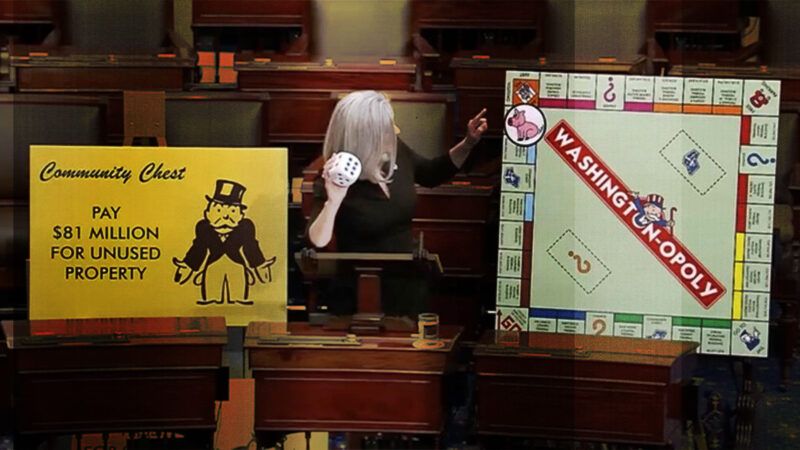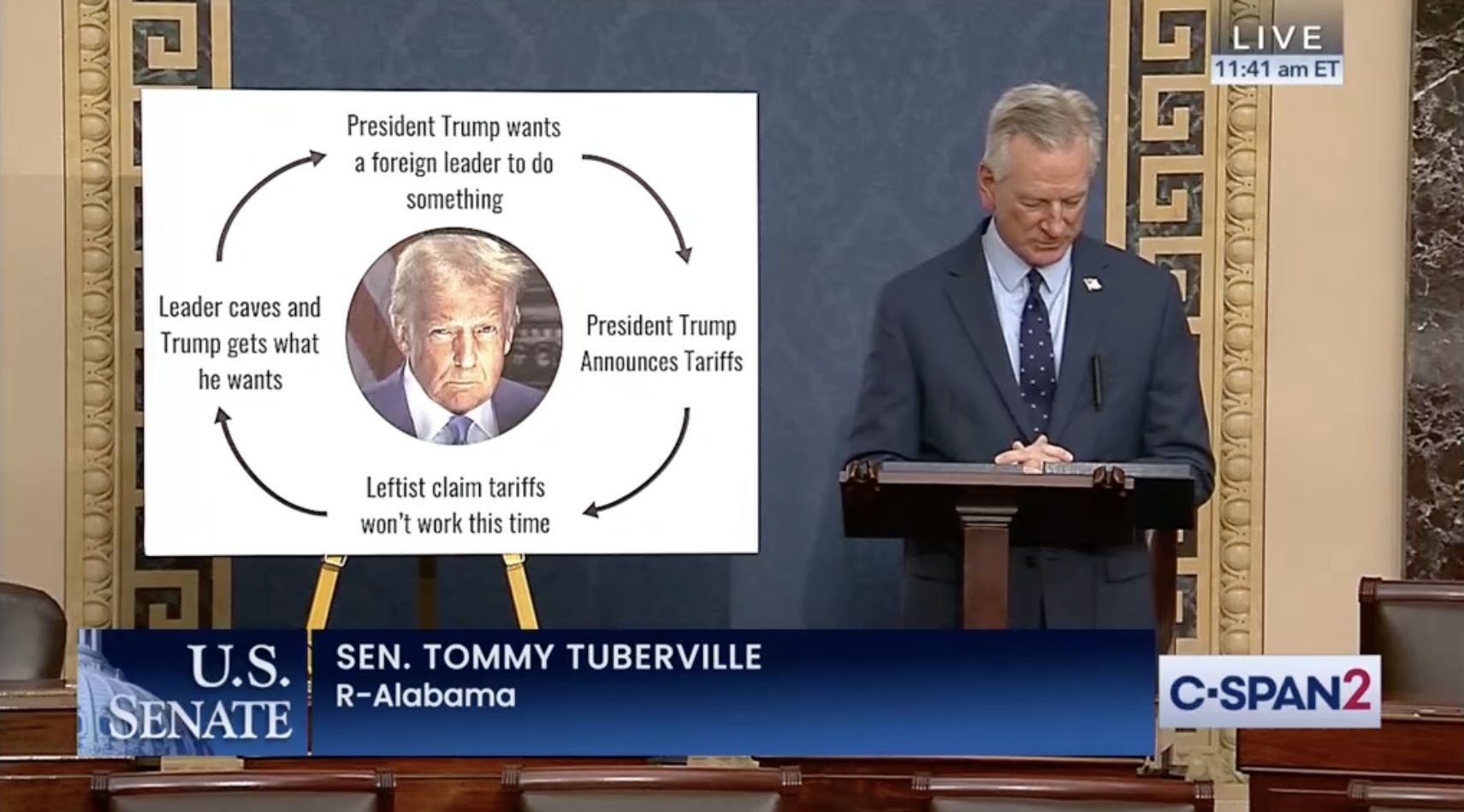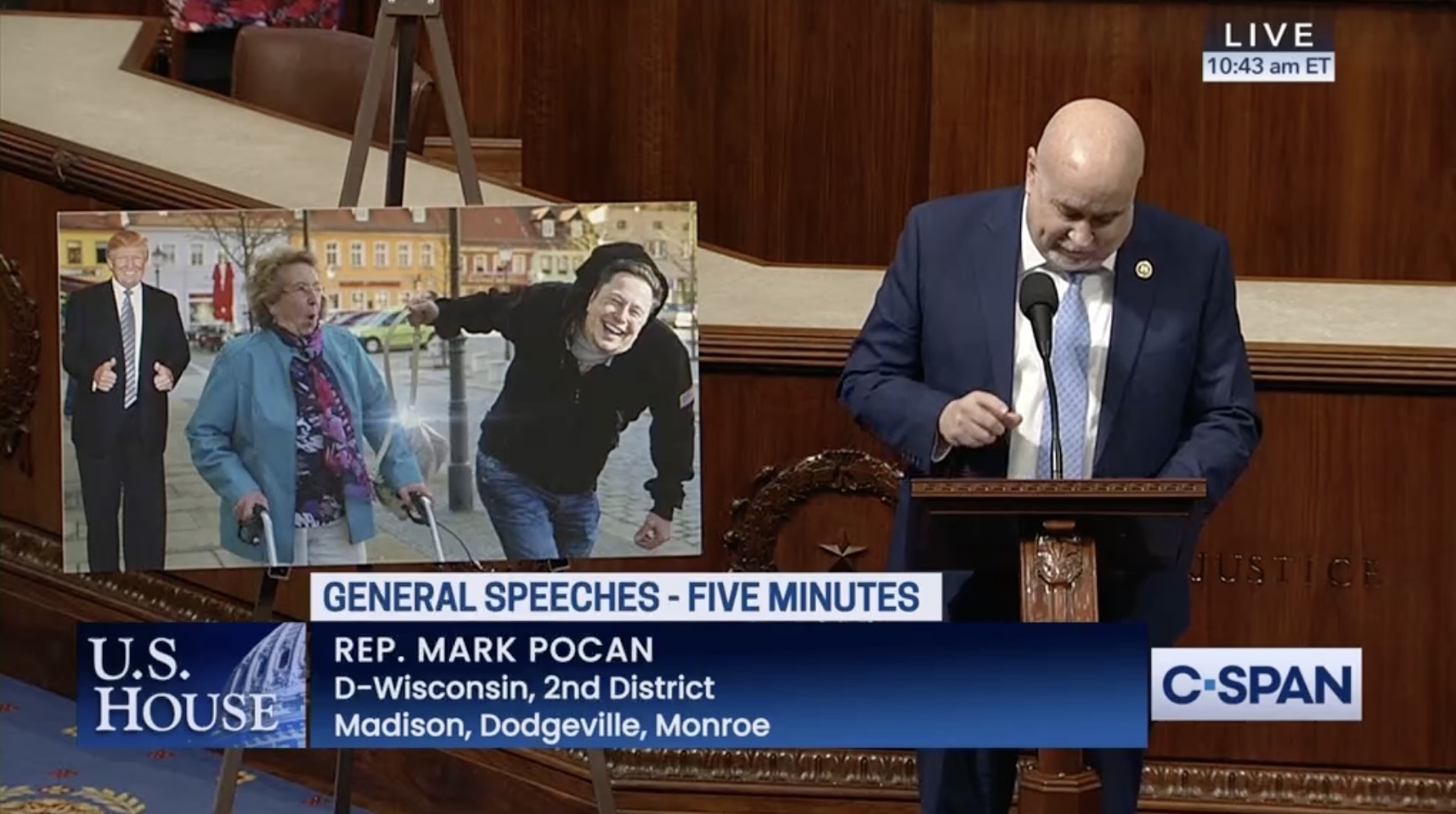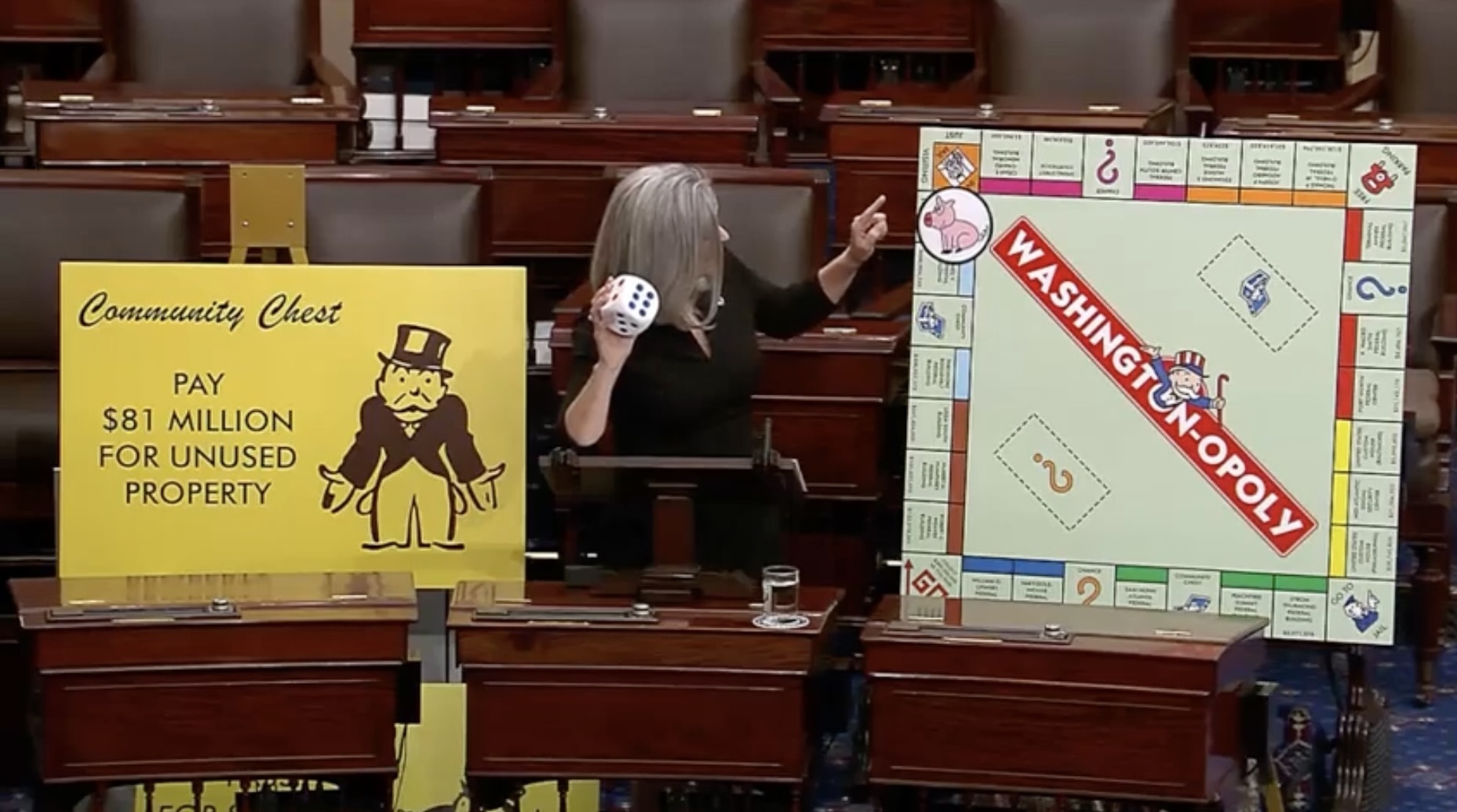Congress Spent At Least $27,500 on Poster Displays in 2 Months. Here Are 4 Ridiculous Examples and 1 Good One.
It's a drop in the bucket compared to the national debt, but any wasteful government spending should be eliminated.

Congress can't even debate a bill without wasting money. In the first two months of this year, it spent at least $27,500 "on printing charts, props, and posters, sticking them on easels (or making staff hold them up) and giving speeches about them," according to FloorCharts, which has been archiving congressional charts and posters since 2012.
That figure was obtained by estimating the average cost of a chart at $50 and totaling the number of charts used by the House and Senate (550) over the two-month period. This number doesn't include all committee charts, but the analysis found that Republicans "used about 20 more charts than Democrats." FloorCharts notes that "this is napkin math, because there is no line item in the office budgets for 'printed charts, props, and posters.'"
That total is a mere drop in the bucket compared to the national debt, but any wasteful government spending should be eliminated. And when you look at the posters the legislators came up with, you'll see that this spending could be very wasteful indeed. Here are four of the most ridiculous posters—and one that we have to admit is pretty good.
1. 'Fire Elon, Save Elmo'

In a March hearing of the House Delivering on Government Efficiency subcommittee, Rep. Greg Casar (D–Texas) used a "Fire Elon, Save Elmo" poster to argue against defunding PBS and NPR. Naturally, the congressman didn't question whether state-funded media is the best use of taxpayer dollars. In any case, evidently no one told Casar that Sesame Street moved to HBO a decade ago before hopping to Netflix this year. Even with PBS defunded, the show has a home.
2. Trump's Tariff Strategy

In February, President Donald Trump kicked off his new tariff regime with new duties on products from China, Canada, and Mexico (the latter two of which he later paused). While many economists warned about the detrimental effects these would have, Sen. Tommy Tuberville (R-Ala.) used a board with some curious capitalization choices to voice his support for the president's policies.
"President Trump's strategic tariffs will strengthen and revitalize our nation's economy, stop the flow of illicit drugs and illegal immigration," said Tuberville on the Senate floor. "President Trump is utilizing every tool at his disposal as we speak, including tariffs to usher in the golden age of the American economy. We have to make that change."
Trump's on-again, off-again tariffs have not, in fact, "strengthened and revitalized" the economy. Rather, they've raised prices for consumers and businesses. Ford, for example, paid "$800 million in tariff-related expenses during the second quarter of 2025" despite "building most of its cars in America," reports Reason's Eric Boehm. Claims that tariffs have halted the flow of "illicit drugs" have proven to be equally dubious.
3. 'DEI in Our Miltary'

At a January hearing considering Pete Hegseth's nomination to be defense secretary, Sen. Eric Schmitt (R–Mo.) used a board to criticize the Biden administration's use of diversity, equity, and inclusion practices in the U.S. military. Schmitt spoke in favor of Hegseth, who he says will restore a warrior ethos, "in stark contrast to the ethos we've seen of the last four said, which is of weakness and wokeness."
Schmitt accused the military of lowering its standards to meet increasingly low recruitment. This would have been more compelling if Schmitt's board didn't misspell "military." Perhaps this board was a subtle foreshadowing of Hegseth's tumultuous tenure at the helm of the Defense Department.
4. Elon Musk Steals an Elderly Woman's Purse as Donald Trump Gives the Thumbs-Up

During a floor speech in February, Rep. Mark Pocan (D–Wis.) used this goofy graphic to denounce Donald Trump, Elon Musk and the Department of Government Efficiency (DOGE). Pocan painted a bleak picture of Musk collecting "$20 billion from taxpayers with one hand while slashing funds for child care, health care, nutrition assistance and public education with the other," but DOGE in fact had only a small impact on the amount of money the government was spending. While Musk originally anticipated that the agency would cut $2 trillion, DOGE now says that it has saved taxpayers only $199 billion—and even that figure has been questioned by many.
5. 'Washington-opoly'

OK, we admit it: This poster is pretty good. It's a highly elaborate "Washington-opoly" board, offering a creative spin on the classic game Monopoly. In remarks delivered to the Senate floor, Sen. Joni Ernst (R–Iowa) played a round to illustrate the government's expansive and expensive real estate portfolio. Ernst pointed out that the Agriculture Department's South Building in Washington, D.C., costs more than $11 million in upkeep, needs nearly $2 million in repairs, and is occupied only 22 percent of the time.
"Uncle Sam gets away with it because Washington plays with its own set of rules. And no matter how you roll the dice, Washington-opoly is a losing game for taxpayers," said Ernst. Those taxpayers paid for Ernst's extravagant Washington-opoly too, but at least this time the poster looks good and makes a solid point.
Editor's Note: As of February 29, 2024, commenting privileges on reason.com posts are limited to Reason Plus subscribers. Past commenters are grandfathered in for a temporary period. Subscribe here to preserve your ability to comment. Your Reason Plus subscription also gives you an ad-free version of reason.com, along with full access to the digital edition and archives of Reason magazine. We request that comments be civil and on-topic. We do not moderate or assume any responsibility for comments, which are owned by the readers who post them. Comments do not represent the views of reason.com or Reason Foundation. We reserve the right to delete any comment and ban commenters for any reason at any time. Comments may only be edited within 5 minutes of posting. Report abuses.
Please to post comments


Pay once, cry once for a big screen tv where memes can be displayed.
Only problem, half the incumbents are 80+ don't know how a tv or computers work.
I see no downside to this.
They could hire Kip to help them. He loves technology (though not as much as he loves Lafawnda).
That seems like a reasonable amount of money to spend on visual aids for an organization that size.
And this from the publication that screeched about most of the DOGE cuts. Now they’re bitching about less than $28k?
When did Reason "screech about the DOGE cuts"? Stop making things up.
If someone were actually listening to most of these speeches, it would be fine, but most of these yahoos are talking to an empty room and a camera for C-Span (which only a couple of insomniacs are watching).
"Congress Spent At Least $27,500 on Poster Displays in 2 Months. Here Are 4 Ridiculous Examples and 1 Good One."
Well, yeah.
Isn't wasting our tax dollars the reason we put democrats and republicans into office in the first place?
Rep. Greg Casar (D–Texas)
The photo is awesome. Dude looks like a Muppet.
These are dumb, but if the chamber doesn't have provisions for a video screen, then I'm not sure what the option is.
Visual communication is key for delivering a message.
I'm pretty conservative and I have to say that that is incredibly cheap since I've worked for large corporate offices that spent far, far more than that on way dumber presentations.
Well, maybe not that much dumber since the one's shown in the story are actually less put together than a high school diorama but then we get the intelligence we vote for, I suppose. If you showed one of those poster boards in a board room for any company I've worked for you'd be fired.
Theater kids gon' theater.
> Ford, for example, paid "$800 million in tariff-related expenses during the second quarter of 2025"
Here's the thing Mandt - if this sort of thing were common I'd think that Reason would have more than that one number to push. But its the only example Reason gives.
Same with the illegal immigrants - There's only one Maryland Man, only one 'makeup artist', etc. If these abuses were as common as asserted you'd have a whole roster of anecdotes to pull from . . . but you only have the one.
>but DOGE in fact had only a small impact on the amount of money the government was spending.
According to Reason DOGE is simultaneously a dangerously out of control organization that will destroy the world by cutting American funding of every-fucking-thing and also an embarrassing failure because they didn't cut very much.
Looked to me like the author is saying the ones he disliked were the ones he didn't agree with, the "one good one" he did agree with.